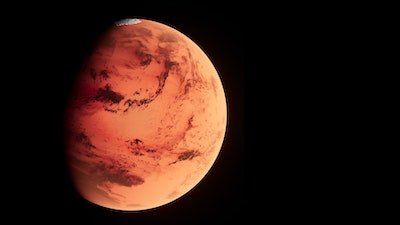
Phoenix Mars Rover Dectects Red Snow
Let it snow, let it snow, let it snow—perhaps the tune the Phoenix Mars lander hums as it goes about its work?
News Source
- BBC News: “Phoenix Detects Red Planet Snow”
Finishing up its work on Mars before winter comes, Phoenix used its LIDAR instrument this week to detect snow forming in clouds high above its current location.
The instrument fires a laser toward the sky, and the beam is scattered off airborne particles—ice crystals, in this case. There are no signs as of yet that the snow actually makes it to the ground, however; it appears the snow is vaporized in midair.
Nonetheless, scientists are eagerly remaining vigilant in case any snow may make it all the way to the surface. “We’re going to be watching very closely over the next month for evidence that the snow is actually landing on the surface,” said York University’s Jim Whiteway, lead scientist for the lander’s weather station.
Any sign of water making it to the surface of the red planet would no doubt excite astrobiologists, who cling to hope—despite years of disappointments—that Mars may still harbor microbial life or signs of it.
In addition to the snow, Phoenix has detected frost, ground fog, and clouds, each occurring more frequently as the weather turns colder. The mission also detected subsurface ice (see More Ice on Mars?), which was considered news this summer.
There are no signs as of yet that the snow actually makes it to the ground, however; it appears the snow is vaporized in midair.
Also, NASA has interpreted certain geological finds on Mars—such as calcium carbonate and possible clays—as other signs of the presence of liquid water on Mars’s surface at some point in the past.
The University of Arizona’s Bill Boynton, lead scientist for the lander’s TEGA instrument, said, “Assuming we really do need liquid water to form these carbonates—which appears to be the case—then what this says is that we might have had standing water at some point in the past.” (Read more on that news at ScienceNOW.) These findings likewise excite evolutionary biologists in their quest for water (and life, as the evolutionary tale goes) on the planet. Of course, there is plenty of geological evidence for water in the history of Mars, but a dearth of evidence of life.
As for Phoenix, it will not be reborn after the winter. As Martian winter comes, Phoenix is receiving less and less sunlight and consequently less power for its solar batteries, even while it must expend more and more energy to warm its systems. By April of next year, the Sun will disappear completely in the Martian Arctic for three months, during which time frost will build up on the lander’s solar panels, leading to cracks and perhaps causing them to fall off. The temperature will eventually fall to -184˚F (-120˚C) and even colder. It almost brings an icy tear to our eyes, since the lander spawned four News to Note items (the weeks of June 7, July 5, August 2, and August 9) during its short life!
Further Reading
- Are Aliens Real?
- The Origin of Life
- Mars, a Testament to Catastrophe
- Was Noah a Martian?
- Water on Mars: A Creationist Response
- NASA Announces Evidence for Water on Mars
- Mission to Mars
For More Information: Get Answers
Remember, if you see a news story that might merit some attention, let us know about it! (Note: if the story originates from the Associated Press, FOX News, MSNBC, the New York Times, or another major national media outlet, we will most likely have already heard about it.) And thanks to all of our readers who have submitted great news tips to us. If you didn’t catch all the latest News to Know, why not take a look to see what you’ve missed?
(Please note that links will take you directly to the source. Answers in Genesis is not responsible for content on the websites to which we refer. For more information, please see our Privacy Policy.)
Recommended Resources

Answers in Genesis is an apologetics ministry, dedicated to helping Christians defend their faith and proclaim the good news of Jesus Christ.
- Customer Service 800.778.3390
- Available Monday–Friday | 9 AM–5 PM ET
- © 2026 Answers in Genesis




